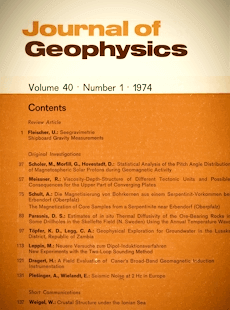Statistical analysis of the pitch angle distribution of magnetospheric Solar protons during geomagnetic activity
Article Sidebar

Vols. 1-18 (1924-1944), ISSN 0044-2801
Main Article Content
Abstract
The pitch angle distributions of energetic Solar protons in the pseudo-trapping region were used in order to examine magnetospheric processes. Temporal and spatial variations of these processes should give insight into the magnetospheric dynamics. Data from two instruments (viewing angle perpendicular and 45° with respect to the local geomagnetic field) on board the low altitude polar orbiting satellite GRS/Azur give a rough measure of the pitch angle distribution of energetic Solar protons (1.5<E<2.7 MeV) over the polar cap. For several Solar particle events the ratios of the counting rates of the two instruments were ordered according to invariant latitude, magnetic local time and geomagnetic activity. The geomagnetic activity was expressed by the time phase relative to the expansion of isolated substorms and the H-component of the magnetic field at a near midnight auroral station. Thus the analysis shows substorm-related effects on energetic particles in the pseudo-trapping region.
 ARK: https://n2t.net/ark:/88439/y019155
ARK: https://n2t.net/ark:/88439/y019155
Permalink: https://geophysicsjournal.com/article/1
Article Details
References
Aubry, M.P., Russell, C.T., Kivelson, M.G. (1970) On inward motion of the magnetopause before a substorm. J. Geophys. Res. 75, 7018-7031
Behannon, K.W. (1970) Geometry of the geomagnetic tail. J. Geophys. Res. 75, 743-753
Bewick, A., Haskell, G.P., Hynds, R.J., Morfill, G. (1973) Low energy solar protons in the pseudo-trapping region of the magnetosphere. J. Geophys. Res. 78, 597-606
Bewick, A., Haskell, G.P., Hynds, R.J. (1970) Penetration of low energy solar protons to low geomagnetic latitudes. J. Geophys. Res. 75, 4605-4612
Blake, J.B., Paulikas, G.A., Freden, S.C. (1968) Latitude intensity structure and pitch angle distributions of low energy solar cosmic rays at low altitude. J. Geophys. Res. 73, 4927-4934
Fairfield, D.H., Ness, N.F. (1970) Configuration of the geomagnetic tail during substorms. J. Geophys. Res. 75, 7032-7047
Flindt, H.R. (1970) Local time dependence of geomagnetic cut-offs for solar protons 0.52 =< Ep =< 4 MeV. J. Geophys. Res. 75, 39-49
Gendrin, R. (1968) Pitch angle diffusion of low energy protons due to gyroresonant interaction with hydromagnetic waves. J. Atmospheric. Terrest. Phys. 30, 1313-1330
Hausler, B., Scholer, M., Hovestadt, D. (197J) Variations of the trapped particle population and of cut-off and pitch angle distribution of simultaneously observed magnetospheric solar protons during substorm activity. Submitted to J. Geophys. Res.
Imhof, W.L., Reagan, J.B., Gaines, E.E. (1971) Solar particle cut-offs as observed at low altitudes. J. Geophys. Res. 76, 4276-4290
McPherron, R.L., Coleman, P.J. (1970) Magnetic fluctuations during magnetospheric substorms. 1. Expansion phase. J. Geophys. Res. 75, 3927-3931
Morfill, G. (1972) A coordinate system for use with high latitude energetic particle phenomena. J. Geophys. Res. 77, 4010--4020
Morfill, G. (1973a) Nonadiabatic particle motion in the magnetosphere. J. Geophys. Res. 78, 588-596
Morfill, G. (1973b) Solar particle access into the inner magnetosphere. Preprint, 7. ESLAB Symposium, Saulgau, Germany
Ness, N.F. (1966) Williams,D.J. Correlated magnetic tail and radiation belt observations. J. Geophys. Res. 71, 322-325
Paulikas, G.A., Blake, J.B., Freden, S.C. (1968) Low energy solar cosmic ray cutoffs: diurnal variations and pitch angle distributions. J. Geophys. Res. 73, 87-95
Paulikas, G.A., Blake, J.B., Vampola, A.L. (1970) Solar particle observations over the polar caps. In: lntercorrelated satellite observations related to solar events. (V. Manno and D. E. Page, eds) Dordrecht-Holland
Roberts, C.S. (1969) Pitch angle diffusion of electrons in the magnetosphere. Rev. Geophys. 7, 305-337
Schindler, K., Ness, N.F. (1972) Internal structure of the geomagnetic neutral sheet. J. Geophys. Res. 77, 91-100
Williams, D.J., Heuring, F.T. (1973) Strong pitch angle diffusion and magnetospheric solar protons. J. Geophys. Res. 78, 37-50
Williams, D.J., Ness, N.F. (1966) Simultaneous trapped electron and magnetic tail field observations. J. Geophys. Res. 71, 5117-5128











